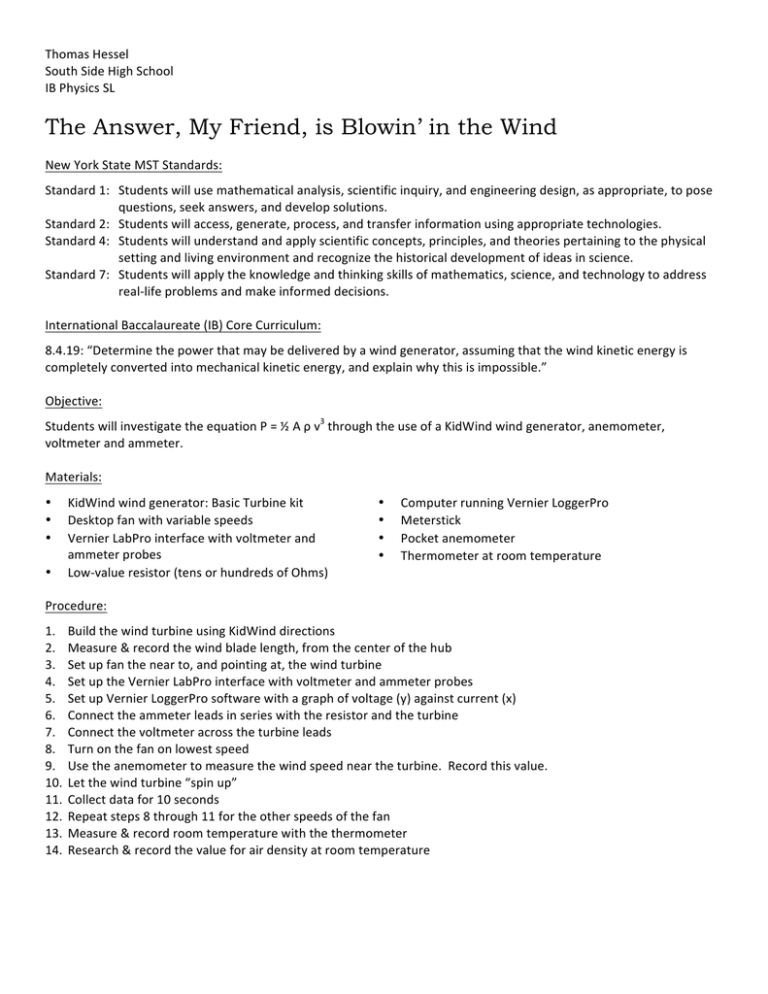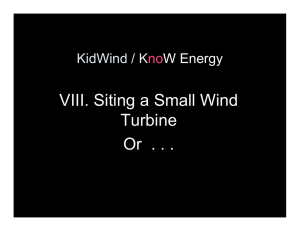Document 10588833
advertisement

Thomas Hessel South Side High School IB Physics SL The Answer, My Friend, is Blowin’ in the Wind New York State MST Standards: Standard 1: Students will use mathematical analysis, scientific inquiry, and engineering design, as appropriate, to pose questions, seek answers, and develop solutions. Standard 2: Students will access, generate, process, and transfer information using appropriate technologies. Standard 4: Students will understand and apply scientific concepts, principles, and theories pertaining to the physical setting and living environment and recognize the historical development of ideas in science. Standard 7: Students will apply the knowledge and thinking skills of mathematics, science, and technology to address real-­‐life problems and make informed decisions. International Baccalaureate (IB) Core Curriculum: 8.4.19: “Determine the power that may be delivered by a wind generator, assuming that the wind kinetic energy is completely converted into mechanical kinetic energy, and explain why this is impossible.” Objective: Students will investigate the equation P = ½ A ρ v3 through the use of a KidWind wind generator, anemometer, voltmeter and ammeter. Materials: • • • KidWind wind generator: Basic Turbine kit Desktop fan with variable speeds Vernier LabPro interface with voltmeter and ammeter probes Low-­‐value resistor (tens or hundreds of Ohms) • Procedure: 1. 2. 3. 4. 5. 6. 7. 8. 9. 10. 11. 12. 13. 14. • • • • Computer running Vernier LoggerPro Meterstick Pocket anemometer Thermometer at room temperature Build the wind turbine using KidWind directions Measure & record the wind blade length, from the center of the hub Set up fan the near to, and pointing at, the wind turbine Set up the Vernier LabPro interface with voltmeter and ammeter probes Set up Vernier LoggerPro software with a graph of voltage (y) against current (x) Connect the ammeter leads in series with the resistor and the turbine Connect the voltmeter across the turbine leads Turn on the fan on lowest speed Use the anemometer to measure the wind speed near the turbine. Record this value. Let the wind turbine “spin up” Collect data for 10 seconds Repeat steps 8 through 11 for the other speeds of the fan Measure & record room temperature with the thermometer Research & record the value for air density at room temperature Questions: 1. Calculate the cross-­‐sectional area of blades, using blade length as the radius of the circle. Show the calculation here: Questions 2 through 4: For each of the wind speeds, do the following: 2. The area beneath the plot of voltage vs. current is the upper limit of the average electrical power from the wind turbine. Determine & record this upper limit of average electrical power from the V vs I graph, for each of the wind speeds. 3. Use the calculated cross-­‐sectional area, the researched value for air density at room temperature, and the measured wind speed to calculate & record the theoretical power from the wind turbine. Show a sample calculation here: 4. Using the two power values (electrical power and theoretical turbine power), calculate the efficiency of the turbine. Show a sample calculation here: 5. Draw a schematic diagram of the circuit here: Questions (continued): 6. What is a short circuit? What is “no-­‐load” voltage? With this in mind, what is the role of the resistor in the circuit? 7. Describe at least three factors that prevent the wind turbine from achieving full 100% efficiency. 8. Is there a difference in the efficiency of the turbine at different wind speeds? If so, what could cause this?






